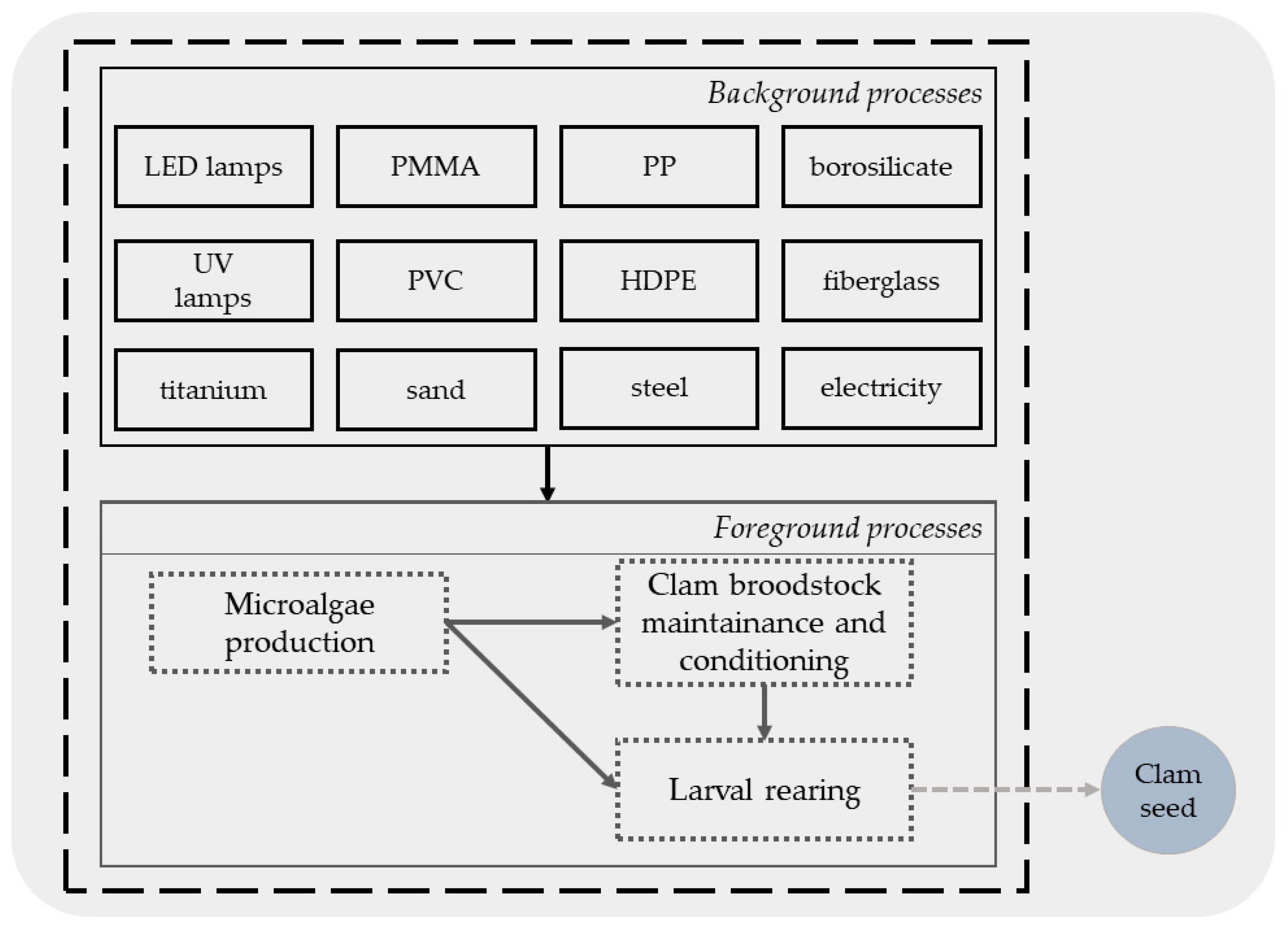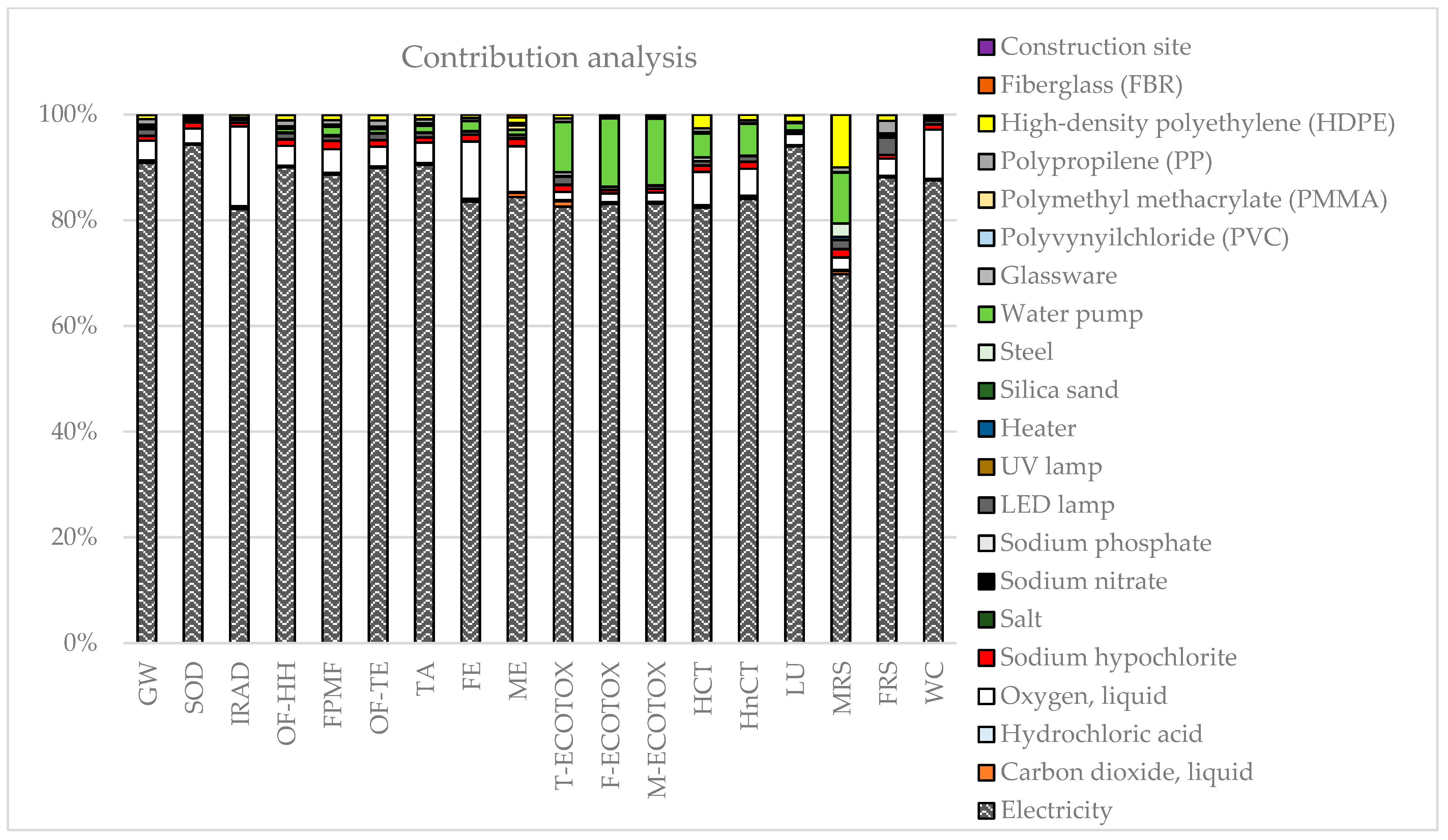Is Manila Clam Farming Environmentally Sustainable? A Life Cycle Assessment (LCA) Approach Applied to an Italian Ruditapes philippinarum Hatchery
Abstract
1. Introduction
2. Materials and Methods
3. Results and Discussion
4. Conclusions
Author Contributions
Funding
Institutional Review Board Statement
Informed Consent Statement
Data Availability Statement
Acknowledgments
Conflicts of Interest
References
- Food and Agriculture Organization (FAO). The State of World Fisheries and Aquaculture 2022. Towards Blue Transformation; FAO: Rome, Italy, 2022; pp. 1–236. [Google Scholar]
- Organisation for Economic Co-operation and Development (OECD); Food and Agriculture Organization (FAO). Fish. In OECD-FAO Agricultural Outlook 2022–2031; OECD Publishing: Paris, France, 2022; pp. 1–363. [Google Scholar]
- Status of Marine Fish and Shellfish Stocks in European Seas. Available online: https://www.eea.europa.eu/ims/status-of-marine-fish-and (accessed on 15 December 2022).
- EUROSTAT. Production from Aquaculture Excluding Hatcheries and Nurseries (from 2008 Onwards). Available online: https://ec.europa.eu/eurostat/databrowser/view/fish_aq2a/default/table?lang=en (accessed on 13 December 2022).
- Monroig, Ó.; Tocher, D.R.; Navarro, J.C. Biosynthesis of Polyunsaturated Fatty Acids in Marine Invertebrates: Recent Advances in Molecular Mechanisms. Mar. Drugs 2013, 11, 3998–4018. [Google Scholar] [CrossRef] [PubMed]
- Surm, J.M.; Prentis, P.J.; Pavasovic, A. Comparative Analysis and Distribution of Omega-3 lcPUFA Biosynthesis Genes in Marine Molluscs. PLoS ONE 2015, 10, e0136301. [Google Scholar] [CrossRef] [PubMed]
- Bridger, D.; Attrill, M.J.; Davies, B.F.R.; Holmes, L.A.; Cartwright, A.; Rees, S.E.; Cabre, L.M.; Sheehan, E.V. The restoration potential of offshore mussel farming on degraded seabed habitat. Aquac. Fish Fish. 2022, 2, 437–449. [Google Scholar] [CrossRef]
- Theuerkauf, S.J.; Barrett, L.T.; Alleway, H.K.; Costa-Pierce, B.A.; Gelais, A.S.; Jones, R.C. Habitat value of bivalve shellfish and seaweed aquaculture for fish and invertebrates: Pathways, synthesis and next steps. Rev. Aquac. 2022, 14, 54–72. [Google Scholar] [CrossRef]
- van der Schatte Olivier, A.; Jones, L.; Le Vay, L.; Christie, M.; Wilson, J.; Malham, S.K. A global review of the ecosystem services provided by bivalve aquaculture. Rev. Aquac. 2020, 12, 3–25. [Google Scholar] [CrossRef]
- Ponti, M.; Abbiati, M.; Ceccherelli, V.U.; Gamba, E.; Ragazzoni, A.; Castellini, A. Decline of the Manila clams stock in the northern Adriatic lagoons: A Survey on Ecological and Socio-Economic Aspects. Acta Adriat. 2017, 58, 89–104. [Google Scholar] [CrossRef]
- Cesari, P.; Pellizzato, M. Molluschi Pervenuti in Laguna Di Venezia per Apporti Volontari o Casuali. Acclimatazione Di Saccostrea commercialis (Iredale & Roughely, 1933) e Di Tapes philippinarum (Adams & Reeve, 1850). Boll. Malacol. 1985, 21, 237–274. [Google Scholar]
- Turolla, E.; Castaldelli, G.; Fano, E.A.; Tamburini, E. Life Cycle Assessment (LCA) Proves that Manila Clam Farming (Ruditapes Philippinarum) Is a Fully Sustainable Aquaculture Practice and a Carbon Sink. Sustainability 2020, 12, 5252. [Google Scholar] [CrossRef]
- Brusà, R.B.; Cacciatore, F.; Ponis, E.; Molin, E.; Delaney, E. Clam culture in the Venice lagoon: Stock assessment of Manila clam (Venerupis philippinarum) populations at a nursery site and management proposals to increase clam farming sustainability. Aquat. Living Resour. 2013, 26, 1–10. [Google Scholar] [CrossRef][Green Version]
- Solidoro, C.; Pastres, R.; Canu, D.M.; Pellizzato, M.; Rossi, R. Modelling the growth of Tapes philippinarum in Northern Adriatic lagoons. Mar. Ecol. Prog. Ser. 2000, 199, 137–148. [Google Scholar] [CrossRef]
- Chiesa, S.; Marzano, F.N.; Minervini, G.; De Lucrezia, D.; Baccarani, G.; Bordignon, G.; Poli, I.; Ravagnan, G.; Argese, E. The invasive Manila clam Ruditapes philippinarum (Adams and Reeve, 1850) in Northern Adriatic Sea: Population genetics assessed by an integrated molecular approach. Fish. Res. 2011, 110, 259–267. [Google Scholar] [CrossRef]
- Gosling, E. Bivalve Molluscs: Biology, Ecology and Culture; Fishing News Books: Oxford, UK, 2003. [Google Scholar]
- Parisi, G.; Centoducati, G.; Gasco, L.; Gatta, P.P.; Moretti, V.M.; Piccolo, G.; Roncarati, A.; Terova, G.; Pais, A. Molluscs and echinoderms aquaculture: Biological aspects, current status, technical progress and future perspectives for the most promising species in Italy. Ital. J. Anim. Sci. 2012, 11, e72. [Google Scholar] [CrossRef]
- Robert, R.; Sánchez, J.L.; Pérez-Parellé, L.; Ponis, E.; Kamermans, P.; O’Mahoney, M. A Glimpse on the Mollusc Industry in Europe. Aquac. Eur. 2013, 38, 5–11. [Google Scholar]
- Food and Agriculture Organization (FAO). Ruditapes philippinarum. Cultured Aquatic Species Information Programme. Text by Goulletquer, P. Fisheries and Aquaculture Division [Online]. Rome. Updated 2006-03-02. Available online: https://www.fao.org/fishery/en/culturedspecies/ruditapes_philippinarum (accessed on 13 December 2022).
- Paesanti, F.; Pellizzato, M. Tapes Philippinarum. Manuale Sulla Vongola Verace Di Allevamento; ESAV: Padova, Italy, 1994. [Google Scholar]
- European Commission. Communication from the Commission to the European Parliament, the Council, the European Economic and Social Committee and the Committee of the Regions. Strategic Guidelines for a More Sustainable and Competitive EU Aquaculture for the Period 2021 to 2030; European Commission: Brussels, Belgium, 2020. [Google Scholar]
- Gambelli, D.; Vairo, D.; Solfanelli, F.; Zanoli, R. Economic performance of organic aquaculture: A systematic review. Mar. Policy 2019, 108, 103542. [Google Scholar] [CrossRef]
- Pulcini, D.; Buttazzoni, L.; Failla, S.; Contò, M.; Capoccioni, F. Organic Aquaculture Production in Italy from 2015 to 2018: Species Production and Nutritional Quality Aspects. J. Aquac. Mar. Biol. Ecol. 2020, 2020, 1–8. [Google Scholar]
- Pucylowski, T. Life Cycle Assessment (LCA) of Oyster Farming in Washington State. Master’s Thesis, University of Washington, Seattle, WA, USA, 2017. [Google Scholar]
- European Commission; Joint Research Centre (JRC); Institute for Environment and Sustainability. International Reference Life Cycle Data System (ILCD) Handbook—General Guide on LCA—Detailed Guidance, 1st ed.; Publications Office of the European Union: Luxembourg, 2010. [Google Scholar]
- Istituto Superiore per la Protezione e Ricerca Ambientale (ISPRA). Indicatori Di Efficienza e Decarbonizzazione Del Sistema Energetico Nazionale e Del Settore Elettrico; ISPRA, Rapporti 343/2021; ISPRA: Rome, Italy, 2021; pp. 1–101. [Google Scholar]
- Cheney, D.P. Bivalve Shellfish Quality in the USA: From the Hatchery to the Consumer. J. World Aquac. Soc. 2010, 41, 192–206. [Google Scholar] [CrossRef]
- European Commission. Farm to Fork Strategy. For a Fair, Healthy and Environmentally-Friendly Food System; European Commission: Brussels, Belgium, 2020. [Google Scholar]
- Ministero dell’Agricoltura, della Sovranità Alimentare e delle Foreste (MASAF). Piano Strategico per l’Acquacoltura Italiana 2021–2027. 2022, pp. 1–164. Available online: https://www.politicheagricole.it/flex/cm/pages/ServeAttachment.php/L/IT/D/1%252F6%252Fe%252FD.caf3bd3d0079b85381bf/P/BLOB%3AID%3D17193/E/pdf?mode=download#:~:text=Il%20Piano%20Strategico%20per%20l,3962%20del%2022%20febbraio%202019) (accessed on 12 January 2023).
- Yaghubi, E.; Carboni, S.; Snipe, R.; Shaw, C.; Fyfe, J.; Smith, C.; Kaur, G.; Tan, S.-Y.; Hamilton, D. Farmed Mussels: A Nutritive Protein Source, Rich in Omega-3 Fatty Acids, with a Low Environmental Footprint. Nutrients 2021, 13, 1124. [Google Scholar] [CrossRef] [PubMed]
- Gephart, J.A.; Henriksson, P.J.G.; Parker, R.W.R.; Shepon, A.; Gorospe, K.D.; Bergman, K.; Eshel, G.; Golden, C.D.; Halpern, B.S.; Hornborg, S.; et al. Environmental performance of blue foods. Nature 2021, 597, 360–365. [Google Scholar] [CrossRef] [PubMed]


| INPUT-MATERIAL | Value | Unit |
|---|---|---|
| Liquid carbon dioxide (CO2) | 120.23 | g |
| Hydrochloric acid (HCl) 37% | 34.76 | g |
| Liquid oxygen (O2) | 1.26 | mc |
| Sodium hypochlorite NaClO 14% | 87.73 | g |
| Sodium nitrate (NaNO3) | 0.45 | g |
| Sodium phosphate (Na₃PO₄) | 0.09 | g |
| Sodium chloride (NaCl) | 93.93 | g |
| Polypropylene (PP) bottles | 1.41 | g |
| Glassware | 0.0010 | pieces |
| High-density polyethylene (HDPE) water container | 0.38 | g |
| Polymethyl methacrylate (PMMA) photobioreactor | 12.62 | g |
| Fiberglass tanks | 2.44 | g |
| Polypropylene (PP) tanks | 21.39 | g |
| Polyvinylchloride (PVC) sieves | 0.66 | g |
| Titanium coil heaters | 0.0001 | pieces |
| Bins (HDPE + aluminum) | 0.0075 | pieces |
| Polypropylene (PP) raceways | 90.18 | g |
| Silica sand | 5.64 | g |
| UV lamps | 0.0023 | pieces |
| LED lamps | 0.0019 | pieces |
| Polyvinyl chloride (PVC) pipe | 3.01 | g |
| Water pump | 0.0001 | pieces |
| Steel machinery | 3.76 | g |
| Electricity | 55.5 | kWh |
| Seawater | 1127 | mc |
| Midpoint Impact Category | Unit | Total |
|---|---|---|
| Global warming (GW) 1 | kg CO2 eq | 2.63 × 101 |
| Stratospheric ozone depletion (SOD) | kg CFC11 eq | 2.00 × 10−5 |
| Ionizing radiation (IRAD) | kBq Co-60 eq | 3.30 × 100 |
| Ozone formation, human health (OF-HH) | kg NOx eq | 5.00 × 10−2 |
| Fine particulate matter formation (FPMF) | kg PM2.5 eq | 3.40 × 10−2 |
| Ozone formation, terrestrial ecosystems (OF-TE) | kg NOx eq | 5.09 × 10−2 |
| Terrestrial acidification (TA) | kg SO2 eq | 9.69 × 10−2 |
| Freshwater eutrophication (FE) | kg P eq | 9.04 × 10−3 |
| Marine eutrophication (ME) | kg N eq | 8.42 × 10−4 |
| Terrestrial ecotoxicity (T-ECOTOX) | kg 1,4-DCB | 8.25 × 101 |
| Freshwater ecotoxicity (F-ECOTOX) | kg 1,4-DCB | 2.83 × 100 |
| Marine ecotoxicity (M-ECOTOX) | kg 1,4-DCB | 3.52 × 100 |
| Human carcinogenic toxicity (HCT) | kg 1,4-DCB | 9.53 × 10−1 |
| Human noncarcinogenic toxicity (HnCT) | kg 1,4-DCB | 2.61 × 101 |
| Land use (LU) | m2a crop eq | 1.01 × 101 |
| Mineral resource scarcity (MRS) | kg Cu eq | 7.34 × 10−2 |
| Fossil resource scarcity (FSR) | kg oil eq | 8.20 × 100 |
| Water consumption (WC) | m3 | 5.70 × 10−1 |
Disclaimer/Publisher’s Note: The statements, opinions and data contained in all publications are solely those of the individual author(s) and contributor(s) and not of MDPI and/or the editor(s). MDPI and/or the editor(s) disclaim responsibility for any injury to people or property resulting from any ideas, methods, instructions or products referred to in the content. |
© 2023 by the authors. Licensee MDPI, Basel, Switzerland. This article is an open access article distributed under the terms and conditions of the Creative Commons Attribution (CC BY) license (https://creativecommons.org/licenses/by/4.0/).
Share and Cite
Martini, A.; Aguiari, L.; Capoccioni, F.; Martinoli, M.; Napolitano, R.; Pirlo, G.; Tonachella, N.; Pulcini, D. Is Manila Clam Farming Environmentally Sustainable? A Life Cycle Assessment (LCA) Approach Applied to an Italian Ruditapes philippinarum Hatchery. Sustainability 2023, 15, 3237. https://doi.org/10.3390/su15043237
Martini A, Aguiari L, Capoccioni F, Martinoli M, Napolitano R, Pirlo G, Tonachella N, Pulcini D. Is Manila Clam Farming Environmentally Sustainable? A Life Cycle Assessment (LCA) Approach Applied to an Italian Ruditapes philippinarum Hatchery. Sustainability. 2023; 15(4):3237. https://doi.org/10.3390/su15043237
Chicago/Turabian StyleMartini, Arianna, Leonardo Aguiari, Fabrizio Capoccioni, Marco Martinoli, Riccardo Napolitano, Giacomo Pirlo, Nicolò Tonachella, and Domitilla Pulcini. 2023. "Is Manila Clam Farming Environmentally Sustainable? A Life Cycle Assessment (LCA) Approach Applied to an Italian Ruditapes philippinarum Hatchery" Sustainability 15, no. 4: 3237. https://doi.org/10.3390/su15043237
APA StyleMartini, A., Aguiari, L., Capoccioni, F., Martinoli, M., Napolitano, R., Pirlo, G., Tonachella, N., & Pulcini, D. (2023). Is Manila Clam Farming Environmentally Sustainable? A Life Cycle Assessment (LCA) Approach Applied to an Italian Ruditapes philippinarum Hatchery. Sustainability, 15(4), 3237. https://doi.org/10.3390/su15043237








